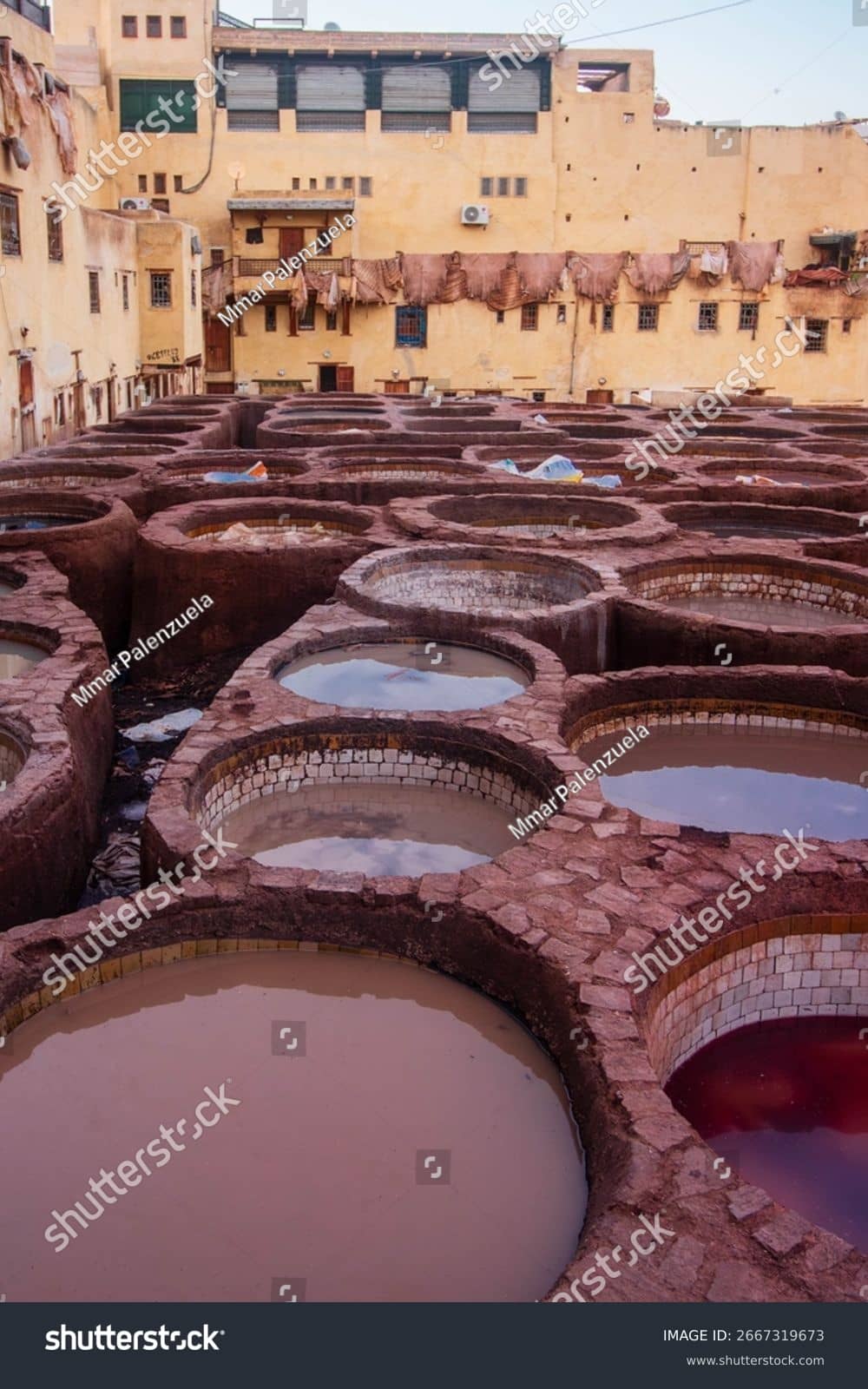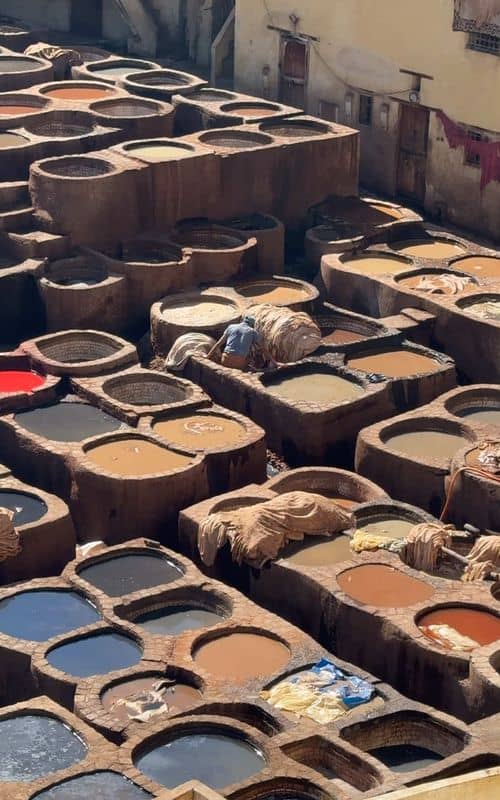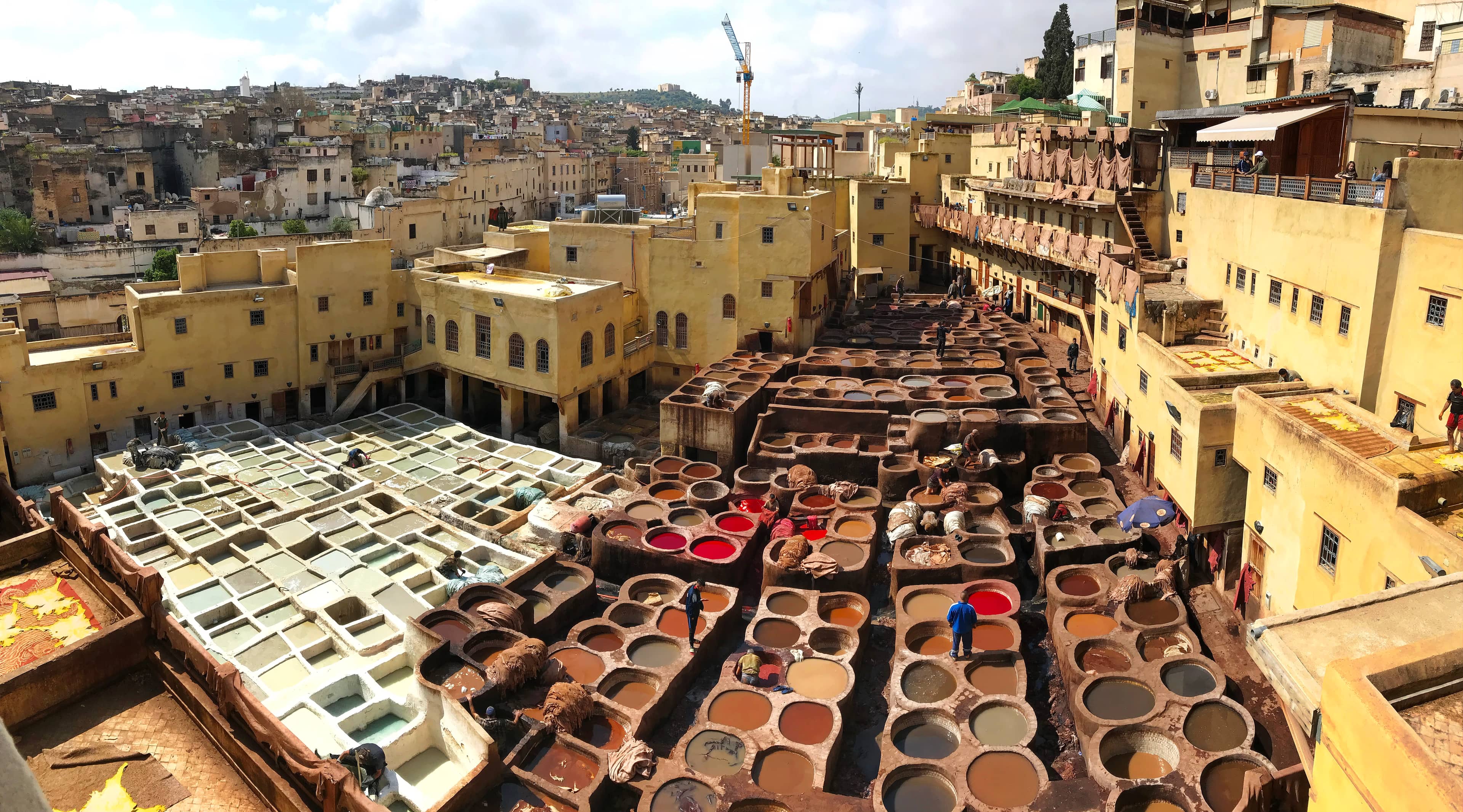Chouara Tannery
Witness centuries-old leather dyeing traditions at Chouara Tannery, Fes's iconic, aromatic heart.

Highlights
Must-see attractions

Social
From TikTok & Reddit
Best Time
Fewer crowds, better light
Chouara Tannery
Best Time
Fewer crowds, better light

Highlights
Must-see attractions
Witness centuries-old leather dyeing traditions at Chouara Tannery, Fes's iconic, aromatic heart.
"Stunning, but at what cost? The Chouara Tannery offers a unique, pungent glimpse into ancient Moroccan craft."
Mint for the Smell
Accept the mint sprigs offered! They genuinely help mask the strong tannery odor. :herb:
Bargain Hard for Leather
Leather prices are highly negotiable. Start low and be prepared to walk away. :moneybag:
Highlights
Discover the most iconic attractions and experiences

The Colorful Dyeing Pits
Chouara Tannery
Witness hundreds of stone vats filled with vibrant natural dyes, creating a stunning visual spectacle.

Traditional Leather Craftsmanship
Chouara Tannery
Observe age-old, manual techniques used to process animal hides into high-quality leather goods.
Panoramic Medina Views
Terraces overlooking the tannery
Enjoy breathtaking views of the ancient medina and the bustling tannery from elevated viewpoints.
Plans like a pro.
Thinks like you
Planning Your Visit
Embrace the Aroma: Prepare for the Scent
Bargaining is Key for Leather Goods
Best Times
Insider Tips
from TikTok, Instagram & Reddit
Mint for the Smell
Accept the mint sprigs offered! They genuinely help mask the strong tannery odor. :herb:
Bargain Hard for Leather
Leather prices are highly negotiable. Start low and be prepared to walk away. :moneybag:
Go Early to Avoid Crowds
Arrive early in the morning to experience the tannery with fewer tourists. :sunrise:
Wear Comfortable Shoes
You'll be walking through narrow medina streets, so comfortable footwear is a must. :athletic_shoe:
Tips
from all over the internet
Mint for the Smell
Accept the mint sprigs offered! They genuinely help mask the strong tannery odor. :herb:
Bargain Hard for Leather
Leather prices are highly negotiable. Start low and be prepared to walk away. :moneybag:
Go Early to Avoid Crowds
Arrive early in the morning to experience the tannery with fewer tourists. :sunrise:
Wear Comfortable Shoes
You'll be walking through narrow medina streets, so comfortable footwear is a must. :athletic_shoe:
Consider a Guided Tour
A local guide can help navigate the medina and enhance your understanding of the tannery process. :map:
What Travellers Say
Reviews Summary
Visitors are captivated by the historical significance and visual spectacle of the Chouara Tannery, marveling at the ancient dyeing techniques. However, the intense, pungent smell is a significant factor, with many recommending mint sprigs to cope. Bargaining for leather goods is expected, though some find prices still high.
"Beautiful place to see some people working very hard, in the traditional way. It does have a strong smell so if you are offered fresh mint to disguise the odour, accept it! You can bargain prices down significantly in the nearby leather stores, even on small items like a belt."
David Smith
"It was within my Fez guided tour which included this stop to see the tanning process that has been here for centuries. You see the tanneries from the top floor of one of leather shops. So, the visit offers you large variety of local leather products if you would like to buy. Generally, it's not that interesting unless you have plenty of time in Fez."
Habib
"The Fez Tanneries (also known as the Chouara Tannery) are one of the most iconic and historic sites in Fez, Morocco, and are renowned for their traditional leather production methods, which have remained largely unchanged since medieval times.
Key Facts:
Location: Fez el-Bali (the old medina of Fez), Morocco.
Established: At least since the 11th century.
Famous Tannery: Chouara Tannery is the largest and most famous among several in Fez.
How It Works:
1. Soaking: Animal hides (usually from cows, sheep, goats, and camels) are first soaked in a mixture of water, limestone, and pigeon droppings to loosen hair and soften the hides.
2. Cleaning: Workers then manually scrape off hair and fat.
3. Dyeing: The cleaned hides are soaked in stone vats filled with natural dyes made from plants and minerals (e.g., poppy for red, saffron for yellow, indigo for blue).
4. Drying: After dyeing, the hides are laid out on rooftops or open air to dry.
Unique Aspects:
Smell: The process produces a strong, pungent odor. Visitors are often given mint leaves to mask the smell.
Handcrafted: Almost all processes are manual, showcasing centuries-old craftsmanship.
Tourism: Popular tourist attraction—visitors usually observe the tannery from nearby terraces overlooking the dyeing pits."
Weaning Ping
What People Like
What People Dislike
Frequently Asked Questions
🚇 🗺️ Getting There
The Chouara Tannery is located in the heart of Fes el-Bali, the old medina. The best way to reach it is by walking through the labyrinthine streets of the medina. Taxis can drop you off at the nearest gate, from where you'll need to navigate on foot. Some visitors recommend hiring a local guide to help navigate the medina and find the tannery easily.
No, private vehicles are not allowed inside the Fes el-Bali medina, where the Chouara Tannery is located. You'll need to park outside the medina and walk or take a petit taxi to the nearest entrance.
The medina is a maze, and finding the tannery can be challenging for first-time visitors. Following signs or asking locals for directions to 'Chouara Tannery' or 'Dar Dbagh' is recommended. Many visitors find a guide helpful.
Exploring the medina on foot is the most authentic experience. Wear comfortable shoes and be prepared for narrow, winding alleys. Consider a guided tour to avoid getting lost and to learn about the history.
Yes, there are several parking lots available on the outskirts of the Fes el-Bali medina. These are convenient if you're arriving by car, and from there you can walk or take a short taxi ride to the medina entrance.
🎫 🎫 Tickets & Entry
There isn't a formal entrance fee to view the tannery from the surrounding leather shops' terraces. However, you'll likely be invited into a shop, and it's customary to make a purchase or tip the guide if you've hired one.
The tannery itself operates continuously, but the best time to visit for viewing is during daylight hours when the dyeing process is active. The surrounding leather shops are typically open from morning until evening.
While there's no direct ticket booth for the tannery itself, access to viewing terraces is usually granted by leather shops. It's expected that you'll browse or purchase items. Some visitors report being charged a small fee by unofficial guides.
It's difficult to get a good view of the tannery without entering one of the adjacent leather shops. The terraces of these shops offer the primary vantage points for visitors.
No, there are no advance booking requirements for visiting the Chouara Tannery. It's a historical site that can be accessed during daylight hours.
📸 📸 Photography
Yes, photography is generally allowed from the terraces of the leather shops. However, be respectful of the workers and avoid intrusive close-ups without permission. Some shops might have specific rules.
Late afternoons often provide beautiful golden hour light, making the colorful dye pits even more vibrant. Early mornings can also offer good light with fewer crowds.
Drone photography is generally not permitted within the medina or over historical sites like the Chouara Tannery due to security and privacy concerns. Always check local regulations.
You can capture stunning shots of the colorful dye pits, the workers processing hides, and panoramic views of the Fes medina. The contrast between the vibrant dyes and the ancient surroundings is very photogenic.
If you hire a guide who also helps with photos, a tip is appreciated. If you're taking photos yourself, focus on capturing the scene respectfully.
🎫 👃 The Smell
The smell is famously strong and pungent, a result of the traditional tanning and dyeing process using natural materials and chemicals. Many visitors find it intense.
Shopkeepers often offer visitors fresh mint sprigs to sniff, which helps to counteract the odor. Some visitors also recommend bringing a scarf or mask.
While unpleasant, the smell is generally not considered dangerous for short-term exposure. However, prolonged exposure to the chemicals used in the process can be harmful to workers.
The smell is from the processing, not the finished leather goods. Once the leather is dyed and dried, it typically doesn't retain the strong odor.
The smell is most potent when you are closest to the dyeing pits. Being on the terraces of the leather shops offers a slightly less intense experience than being at ground level.
🎫 🛍️ Shopping & Bargaining
The leather goods are generally considered to be of good quality, made using traditional methods. You can find a variety of items like jackets, bags, belts, and wallets.
Prices vary greatly, but Redditors suggest that even after bargaining, items can still be overpriced compared to other places in Morocco. A belt might cost around 40 MAD, and a bag around 250 MAD.
Start by offering about half of the initial price and negotiate upwards. Be polite but firm, and don't be afraid to walk away if the price isn't right.
Typically, you purchase leather goods from the shops that overlook the tannery, not directly from the workers in the pits. These shops are where the bargaining takes place.
You can find a wide range of leather products, including jackets, bags, wallets, belts, poufs, and traditional Moroccan slippers (babouches).
For Different Travelers
Tailored advice for your travel style
👨👩👧 Families with Kids
💰 Budget Travelers
📸 Photography Enthusiasts
Deep Dives
In-depth insights and expert knowledge
A Glimpse into Centuries of Craftsmanship
Following the initial soaking, workers manually scrape away the hair and fat from the hides. The next crucial step is dyeing, where the cleaned hides are submerged in large stone vats filled with vibrant natural pigments. These dyes are derived from plants and minerals, with colors like saffron for yellow, indigo for blue, and poppy for red creating the iconic visual spectacle. The intense, pungent smell that permeates the air is a direct result of this traditional dyeing process, a sensory experience that many visitors find unforgettable.
Visitors typically observe this ancient craft from the terraces of surrounding leather shops. These shops offer a panoramic view of the colorful pits and the workers diligently carrying out their tasks. While the process is visually striking, it's important to be aware that the chemicals used, though natural, can pose health risks to the workers. Despite these challenges, the Chouara Tannery continues to be a vital part of Fes's heritage and economy, showcasing a dedication to tradition that has endured for centuries.
Navigating the Fes Medina and the Tannery Experience
Upon arrival near the tannery, you'll likely be approached by locals offering tours or inviting you into leather shops. While some may seem like scams, a guided tour can be very helpful in sparing you time and effort. It's important to agree on a price beforehand and be clear about what the tour includes. Even if you don't plan to buy, visiting the terraces of the leather shops is essential for viewing the tannery. Be prepared for the strong smell; accepting the offered mint sprigs is a common and effective way to cope.
When it comes to shopping for leather goods, bargaining is an integral part of the experience. Prices are often inflated, and Redditors advise starting negotiations at around half the asking price and being prepared to haggle. While the quality of the leather is generally good, some visitors note that prices can still be high even after bargaining. Consider what you're willing to pay and be firm but polite.


Social
from TikTok, Instagram & Reddit